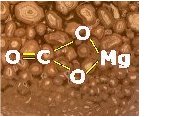
Each individual mineral and rock has a distinct chemical composition which can be written as chemical formula. Except for native elements, minerals are salts composed of positively charged cations (e.g. K+, Na+, Ca++, Fe+++) and negatively charged anionic groups (e.g. CO3, PO4). The list below gives the main mineral groups and examples of each corresponding anionic group.
Silicates - are the largest group. About 86% of the earth's volume is silicate. A complex form of other materials often surrounds silicate because of its ability to polymerise. The silicate group has been subdivided into a number of smaller groups using their mineral structures as a basis. These include:
- Tectosilicates - quartz, feldspars, zeolites
- Phyllosilicates - micas, serpentines, clays, chlorites
- Inosilicates - pyroxenes, pyroxinoids
- Cyclosilicates - tourmalines, beryl
- Sorosilicates - epidote, vesuvianite
- Nesosilicates - garnets, olivine, alumino-silicates



